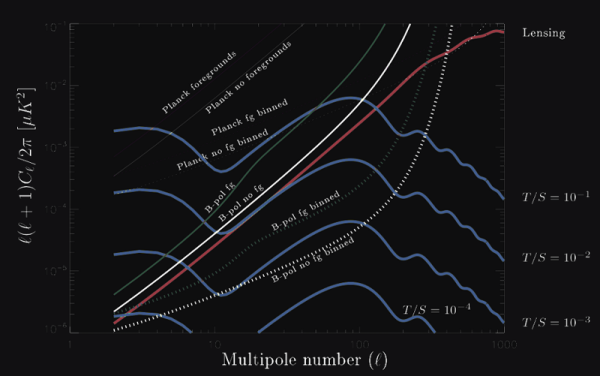"If you are not completely confused by quantum mechanics, you do not understand it." -John Wheeler
Now that LIGO has detected gravitational waves directly, it's time to examine all the different sources that they come from, and what they can teach us about the Universe. While accelerating masses in strong gravitational fields -- black holes, neutron stars and the like -- will produce gravitational waves capable of being seen by direct detection experiments, there's another class of gravitational waves that's observable through its effects on the leftover light from the Big Bang: gravitational waves from inflation.
 Image credit: National Science Foundation (NASA, JPL, Keck Foundation, Moore Foundation, related) – Funded BICEP2 Program.
Image credit: National Science Foundation (NASA, JPL, Keck Foundation, Moore Foundation, related) – Funded BICEP2 Program.
Unlike all the other sources of gravitational waves, however, the ones from inflation are purely quantum in origin: if gravitation is not a fundamentally quantum force, these fluctuations cannot exist! To discover this signature would teach us that Einstein's relativity is not the final, fundamental theory of gravity, and that a truly quantum theory is needed to describe our Universe. Current and planned experiments will probe for this signal down to an improved factor of 100 over where we are now, giving us all the hope in the world that we'll find it.


BICEP came to grief because there was another source (IIRC polarized stuff in galactic mag fields), that mimicked the signal they were looking for. So it seems that more than just sensitivity of the equipment is required. You also have to be able to rule out more mundane causes for the signal.
Hi Ethan,
I have a question about the gravitational wave, since they detected the wave in Sept, can they figure out the amplitude, period, and wavelength of such a wave and predict when the next wave from this event of black holes colliding pass through Earth?
@Niteen Lewis #2: You asked two questions. Yes, the LIGO collaboration figured out the amplitude, period, and wavelength(s) of the signal they detected. No, we cannot predict when another such event will be detected, because we don't know where or when two compact objects will merge.
@#3 Michael.
I rather think Niteen was asking when the next wave from the same event might pass by earth:- in his words -
"predict when the next wave from this event"
:)
Thanks for the response @Michael.. thanks for stepping in @PJ..you are right..my second question :) was if we can predict the next wave from 'this' very event based on the information we have.. my thoughts were if we know or have calculated all the information about this wave then we should be able to tell when the next wave will pass through.. and that I think would be an awesome discovery.. @Ethan, just heard your podcast on Patreon and that helped explain the nature of this wave.. double thumbs up for that !!
@PJ #4 and Niteen #5: The GW event observed in September was produced in a single, one-time-only event -- the merger of two black holes to form a single, larger black hole. Once that merger is finished, it doesn't produce any additional gravitational waves. What we saw in September is all there ever will be from that particular event.
The next GW event will come from another single, one-time-only event. Some other binary system (two compact objects orbiting one another) will spiral together, emit a single burst of gravitational waves, and then stop.
When will that happen? Where in the Universe will it be? We don't know, and can't predict. That's why the detectors (LIGO, VIRGO, GEO600, etc.) are turned on and waiting for a signal, all the time (except when they're off for maintenance or improvements :-).
Occurred to me that if the structure beyond our view is a group of similarly charged and near infinitely massive objects, then the focus of gravitational and repulsive forces would be at those spaces between.
When a space is near completely void of mass, the energy focused at that convergent point could spontaneously convert to mass, which then falls outward toward the areas of infinite mass, accelerating until it reaches the speed of light.
At that speed, the mass, converted to energy, could pass through a supermassive object as a wave, recondensing to matter when it slows to sub light speed at a quantum distance from the super massive object, where it returns to complete a cycle.
Any likelihood?
Thanks so much for your kind indulgence,
You are using complex words in the mistaken idea that they will explain a complex idea. Unfortunately, they only confuse what you're trying to say.
This may, and given this is the internet, with a high probability, be deliberate.
https://www.washingtonpost.com/news/wonk/wp/2015/12/01/the-kinds-of-peo…
Please prove my lack of faith in internet science questions unwarranted and use simpler terms more clearly to re-describe your claims.
Because at the moment, "No" would be the answer to your question.
Given the multiple semantic questions that the boldfaced text presents, I'm just going to send you to W—ia to point out that converting mass into energy is a lot easier than the other way around: for example, 10⁹ K – an order of magnitude shy of producing electrons – is about the temperature of the universe 100–s after the big bang.
^ I'm also going to risk making a complete fool of myself and naively divide the LHC's 13 TeV by the Boltzmann constant to arrive at 9.4 × 10
³⁵K.@Stephen #7
"Occurred to me that if the structure beyond our view is a group of similarly charged and near infinitely massive objects,"
Occured to me that you have no idea what you are talking about... not to mention no proof.